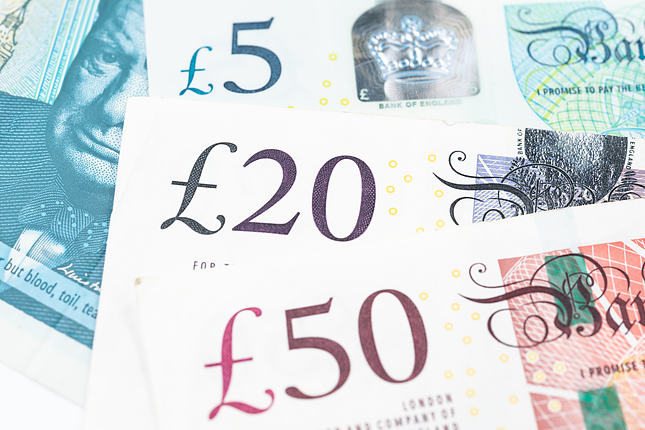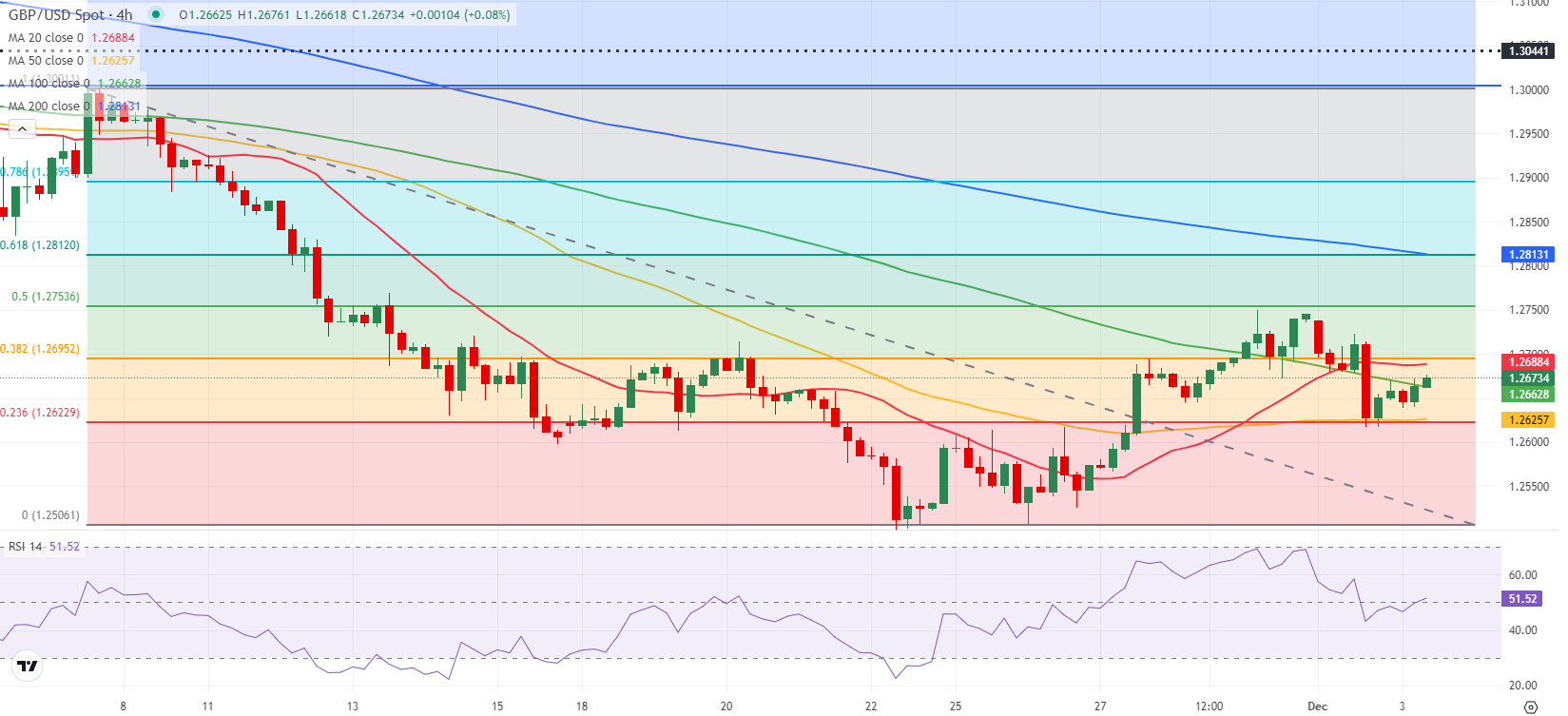- GBP/USD holds above 1.2650 after closing deep in the red on Monday.
- The near-term technical outlook points to a lack of bearish momentum.
- The US economic calendar will feature JOLTS Job Openings data.
GBP/USD fell more than 0.5% on Monday and snapped a three-day winning streak. The pair consolidates its losses early Tuesday and trades marginally higher on the day above 1.2650.
British Pound PRICE This week
The table below shows the percentage change of British Pound (GBP) against listed major currencies this week. British Pound was the weakest against the US Dollar.
| USD | EUR | GBP | JPY | CAD | AUD | NZD | CHF | |
|---|---|---|---|---|---|---|---|---|
| USD | 0.68% | 0.50% | 0.26% | 0.25% | 0.28% | 0.45% | 0.74% | |
| EUR | -0.68% | -0.22% | -0.38% | -0.43% | -0.30% | -0.22% | 0.08% | |
| GBP | -0.50% | 0.22% | -0.19% | -0.21% | -0.07% | 0.00% | 0.26% | |
| JPY | -0.26% | 0.38% | 0.19% | -0.03% | 0.05% | 0.21% | 0.40% | |
| CAD | -0.25% | 0.43% | 0.21% | 0.03% | 0.20% | 0.21% | 0.48% | |
| AUD | -0.28% | 0.30% | 0.07% | -0.05% | -0.20% | 0.07% | 0.33% | |
| NZD | -0.45% | 0.22% | -0.00% | -0.21% | -0.21% | -0.07% | 0.28% | |
| CHF | -0.74% | -0.08% | -0.26% | -0.40% | -0.48% | -0.33% | -0.28% |
The heat map shows percentage changes of major currencies against each other. The base currency is picked from the left column, while the quote currency is picked from the top row. For example, if you pick the British Pound from the left column and move along the horizontal line to the US Dollar, the percentage change displayed in the box will represent GBP (base)/USD (quote).
In the absence of high-impact macroeconomic data releases, the US Dollar (USD) benefited from the risk-averse market atmosphere on Monday and gathered strength against its rivals. Early Tuesday, US stock index futures trade mixed, pointing to a cautious stance.
Nevertheless, Pound Sterling manages to limit its losses against the USD. EUR/GBP fell for four consecutive trading days on Monday and continued to edge lower early Tuesday, suggesting that Pound Sterling captures some capital outflows out of the Euro.
In the second half of the day, October JOLTS Job Openings data will be featured in the US economic calendar. In case the number of job openings arrive at or above 8 million, the USD could outperform its rivals with the immediate reaction and weigh on GBP/USD.
Later in the American session, Federal Reserve (Fed) Governor Adriana Kugler and Chicago Fed President Austran Goolsbee will be delivering speeches. On Monday, Atlanta Fed President Bostic said that he is undecided on whether a rate cut is needed in December. Similarly, "one could argue a case for skipping a rate cut in December, will be watching data closely to decide," NY Fed President John Williams argued. In case Fed policymakers continue to sound cautious about a rate reduction in December, the USD could preserve its bullish momentum. According to the CME FedWatch Tool, markets are currently pricing in about a 72% probability of a 25 basis points (bps) cut in December.
GBP/USD Technical Analysis
The Relative Strength Index (RSI) indicator on the 4-hour chart moves sideways near 50, highlighting a lack of bearish momentum. Additionally, GBP/USD was last seen trading slightly above the 100-period Simple Moving Average (SMA) after staying below this level in the second half of the day on Monday.
On the upside, 1.2700 (Fibonacci 38.2% retracement of the latest downtrend) aligns as first resistance before 1.2750 (Fibonacci 50% retracement) and 1.2810 (Fibonacci 61.8% retracement, 200-period SMA). If GBP/USD drops below 1.2660 (100-period SMA) and confirms that level as resistance), technical sellers could show interest. In this scenario, 1.2620 (50-period SMA, Fibonacci 23.6% retracement) could be seen as next support.
Pound Sterling FAQs
The Pound Sterling (GBP) is the oldest currency in the world (886 AD) and the official currency of the United Kingdom. It is the fourth most traded unit for foreign exchange (FX) in the world, accounting for 12% of all transactions, averaging $630 billion a day, according to 2022 data. Its key trading pairs are GBP/USD, also known as ‘Cable’, which accounts for 11% of FX, GBP/JPY, or the ‘Dragon’ as it is known by traders (3%), and EUR/GBP (2%). The Pound Sterling is issued by the Bank of England (BoE).
The single most important factor influencing the value of the Pound Sterling is monetary policy decided by the Bank of England. The BoE bases its decisions on whether it has achieved its primary goal of “price stability” – a steady inflation rate of around 2%. Its primary tool for achieving this is the adjustment of interest rates. When inflation is too high, the BoE will try to rein it in by raising interest rates, making it more expensive for people and businesses to access credit. This is generally positive for GBP, as higher interest rates make the UK a more attractive place for global investors to park their money. When inflation falls too low it is a sign economic growth is slowing. In this scenario, the BoE will consider lowering interest rates to cheapen credit so businesses will borrow more to invest in growth-generating projects.
Data releases gauge the health of the economy and can impact the value of the Pound Sterling. Indicators such as GDP, Manufacturing and Services PMIs, and employment can all influence the direction of the GBP. A strong economy is good for Sterling. Not only does it attract more foreign investment but it may encourage the BoE to put up interest rates, which will directly strengthen GBP. Otherwise, if economic data is weak, the Pound Sterling is likely to fall.
Another significant data release for the Pound Sterling is the Trade Balance. This indicator measures the difference between what a country earns from its exports and what it spends on imports over a given period. If a country produces highly sought-after exports, its currency will benefit purely from the extra demand created from foreign buyers seeking to purchase these goods. Therefore, a positive net Trade Balance strengthens a currency and vice versa for a negative balance.
Information on these pages contains forward-looking statements that involve risks and uncertainties. Markets and instruments profiled on this page are for informational purposes only and should not in any way come across as a recommendation to buy or sell in these assets. You should do your own thorough research before making any investment decisions. FXStreet does not in any way guarantee that this information is free from mistakes, errors, or material misstatements. It also does not guarantee that this information is of a timely nature. Investing in Open Markets involves a great deal of risk, including the loss of all or a portion of your investment, as well as emotional distress. All risks, losses and costs associated with investing, including total loss of principal, are your responsibility. The views and opinions expressed in this article are those of the authors and do not necessarily reflect the official policy or position of FXStreet nor its advertisers. The author will not be held responsible for information that is found at the end of links posted on this page.
If not otherwise explicitly mentioned in the body of the article, at the time of writing, the author has no position in any stock mentioned in this article and no business relationship with any company mentioned. The author has not received compensation for writing this article, other than from FXStreet.
FXStreet and the author do not provide personalized recommendations. The author makes no representations as to the accuracy, completeness, or suitability of this information. FXStreet and the author will not be liable for any errors, omissions or any losses, injuries or damages arising from this information and its display or use. Errors and omissions excepted.
The author and FXStreet are not registered investment advisors and nothing in this article is intended to be investment advice.
Recommended Content
Editors’ Picks

EUR/USD recovers above 1.0300, markets await comments from Fed officials
EUR/USD gains traction and trades above 1.0300 on Thursday despite mixed German Industrial Production and Eurozone Retail Sales data. Retreating US bond yields limits the USD's gains and allows the pair to hold its ground as market focus shifts to Fedspeak.

GBP/USD rebounds from multi-month lows, trades above 1.2300
GBP/USD erases a portion of its daily gains and trades above 1.2300 after setting a 14-month-low below 1.2250. The pair recovers as the UK gilt yields correct lower after surging to multi-year highs on a two-day gilt selloff. Markets keep a close eye on comments from central bank officials.

Gold climbs to new multi-week high above $2,670
Gold extends its weekly recovery and trades at its highest level since mid-December above $2,670. The benchmark 10-year US Treasury bond yield corrects lower from the multi-month high it touched above 4.7% on Wednesday, helping XAU/USD stretch higher.

Bitcoin falls below $94,000 as over $568 million outflows from ETFs
Bitcoin continues to edge down, trading below the $94,000 level on Thursday after falling more than 5% this week. Bitcoin US spot Exchange Traded Funds recorded an outflow of over $568 million on Wednesday, showing signs of decreasing demand.

How to trade NFP, one of the most volatile events Premium
NFP is the acronym for Nonfarm Payrolls, arguably the most important economic data release in the world. The indicator, which provides a comprehensive snapshot of the health of the US labor market, is typically published on the first Friday of each month.

Best Forex Brokers with Low Spreads
VERIFIED Low spreads are crucial for reducing trading costs. Explore top Forex brokers offering competitive spreads and high leverage. Compare options for EUR/USD, GBP/USD, USD/JPY, and Gold.
